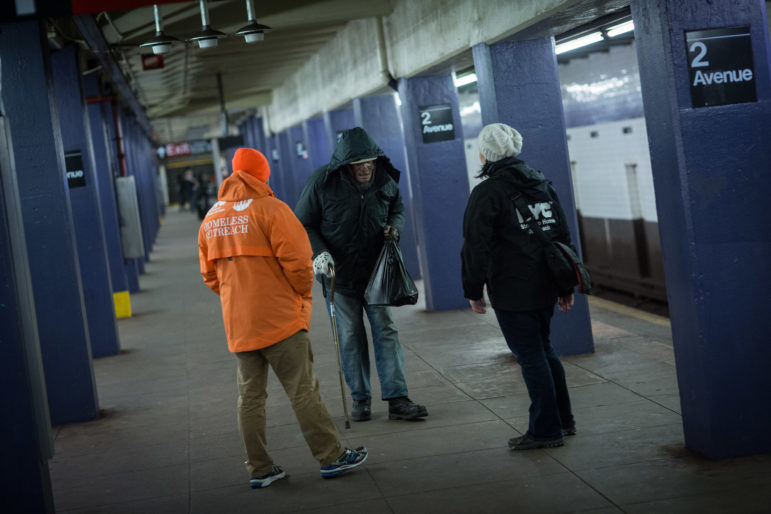“We need a continuum of care that meets the individual needs of homeless New Yorkers where they are, whether it’s a single mother, an out-of-work man, someone exiting incarceration with nowhere to go, a person living with schizophrenia or battling addiction, and everyone in between.”

Michael Appleton/Mayoral Photography Office
Homeless outreach workers in the subway system in 2016.New York City’s homelessness crisis has become impossible to ignore. We see it every day in the proliferation of tent encampments and we feel it in our eroding sense of public safety.
The city has attempted to address this crisis through Housing First: an approach that, in broadest terms, prioritizes providing supportive housing to the most vulnerable people experiencing homelessness.
At The Doe Fund, we have embraced Housing First. Our portfolio of permanent affordable and supportive housing has expanded to over 850,000 square feet across 12 residences in operation and development. These facilities serve New York’s most at-risk citizens, including families, veterans, and people with physical disabilities and mental illnesses.
But we also know that Housing First policies alone are not enough to end homelessness. Too often—as in the case of rapid re-housing—it provides only a temporary respite from homelessness, not permanent solutions.
A recent City Limits article noted that while moving unsheltered people directly into supportive housing could serve those in most desperate need, “[s]upportive housing is not the best fit for many street homeless New Yorkers.” That’s an understatement: about 73 percent don’t even meet eligibility requirements (the designation of being “chronically homeless” alongside mental illness and/or substance abuse disorder). Although unsheltered people living with mental illnesses are the most visible examples of homelessness, they represent only a small subset of the homeless population. Where are the answers for the rest?
READ MORE: What Would It Take to Move Street Homeless New Yorkers into Housing?
Despite New York City’s claimed adherence to Housing First, the barriers and bureaucracy between housing and those who need it have only increased. Five years ago, it took an average of eight weeks for The Doe Fund to place individuals experiencing homelessness from our transitional residences into permanent housing. Today, it takes nearly six months.
It’s no coincidence that the barriers to building affordable and supportive housing in New York City have increased, too. We’ve advocated for numerous solutions to lower these barriers, including subsidizing the financing, construction, management, and operation of new and existing housing; changing financing and zoning laws to develop modern SROs; raising Floor Area Ratio minimums for affordable and supportive housing; creating a Community Land Trust for nonprofits to build housing; chartering an Affordable Housing Bank; upzoning to build affordable and supportive housing; and amending CityFHEPS housing vouchers to adjust by income level, as well as increasing the income eligibility and limit, so more people qualify.
Even these reforms will only address part of the problem, because lack of housing is only one of the many underlying causes of homelessness. What’s missing from the conversation is that people experiencing homelessness are not a monolith.
We need a continuum of care that meets the individual needs of homeless New Yorkers where they are, whether it’s a single mother, an out-of-work man, someone exiting incarceration with nowhere to go, a person living with schizophrenia or battling addiction, and everyone in between. That means more and easier access to permanent housing, but also more shelters and supportive services to help people stabilize and re-enter the community. It means upstream investments in marginalized communities to address our city’s vast racial and socioeconomic disparities.
Most important of all, for the largest segment of the homeless population—single adults who can work—it means access to economic opportunity: employment alongside workforce development training for careers that pay living wages.
Nonprofit programs like ACE, HOPE, First Step, and our own Ready, Willing & Able provide just that. In the case of Ready, Willing & Able, participants gain immediate access to paid work on cleaning crews that service over 115 miles of city streets. This allows them to earn an income, acclimate to a working environment (over 25 percent of the individuals we serve have been out of work for five years or more), and learn soft skills—all while addressing New York’s epidemic of dirty streets. Participants then transition to paid training programs for high-demand careers, including in skilled trades like welding.
Together, nonprofits can partner to provide a working solution to homelessness. But we need support from the private sector and bold vision from City Hall. Above all, our leaders must understand that housing is only one piece of the puzzle when it comes to addressing this crisis.
Harriet Karr-McDonald is President of The Doe Fund








One thought on “Opinion: ‘Housing First’ is Not Enough to End NYC Homelessness”
Recent publications and analysis documented that housing first does not reduce homelessness and in fact many of the chronically mentally ill do not achieve the desired outcomes. California just implemented a shift in its approach and adopted the notion of treatment first. Its about time NY will establish accountability for the citizens our tax dollars support.
https://nypost.com/2022/07/15/more-housing-isnt-the-solution-to-homelessness-its-treatment/?utm_campaign=iphone_nyp&utm_source=message_app